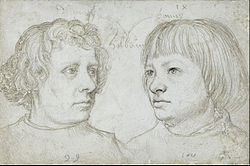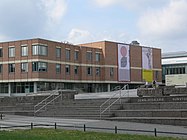Fitxer:Holbein portrait.png

Mida d'aquesta previsualització: 800 × 527 píxels. Altres resolucions: 320 × 211 píxels | 640 × 421 píxels | 1.030 × 678 píxels.
Fitxer original (1.030 × 678 píxels, mida del fitxer: 1,22 Mo, tipus MIME: image/png)
Historial del fitxer
Cliqueu una data/hora per veure el fitxer tal com era aleshores.
| Data/hora | Miniatura | Dimensions | Usuari/a | Comentari | |
|---|---|---|---|---|---|
| actual | 17:59, 15 juny 2006 |  | 1.030 × 678 (1,22 Mo) | Carlbaratta | Ambrosius and Hans Holbein 1511 Silverpoint on white-coated paper, 10.3 x 15.5 cm Kupferstichkabinett, Staatliche Museen, Berlin Metal Point In medieval times, metal point was used as the primary permanent mark-making tool for both artists and scribes. |
Ús del fitxer
La pàgina següent utilitza aquest fitxer:
Ús global del fitxer
Utilització d'aquest fitxer en altres wikis:
- Utilització a arz.wikipedia.org
- Utilització a be.wikipedia.org
- Utilització a cs.wikipedia.org
- Utilització a el.wikipedia.org
- Utilització a en.wikipedia.org
- Utilització a es.wikipedia.org
- Utilització a fi.wikipedia.org
- Utilització a fy.wikipedia.org
- Utilització a it.wikipedia.org
- Utilització a nn.wikipedia.org
- Utilització a no.wikipedia.org
- Utilització a pl.wikipedia.org
- Utilització a pt.wikipedia.org
- Utilització a ru.wikipedia.org
- Utilització a sh.wikipedia.org
- Utilització a sr.wikipedia.org
- Utilització a www.wikidata.org



